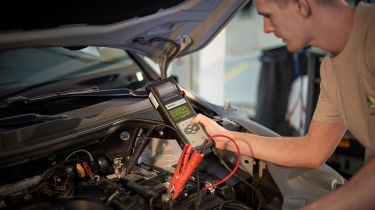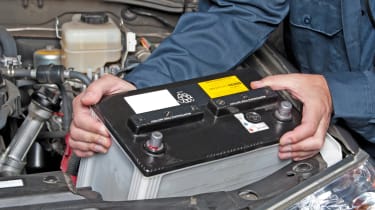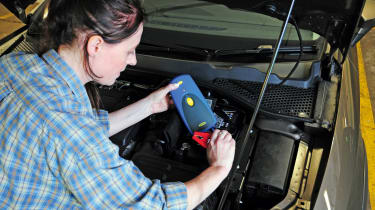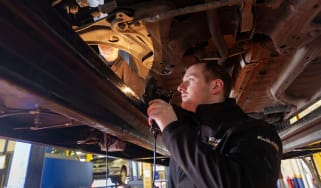How to test and charge a car battery
When your car won’t start, a flat battery is often the culprit. Here is everything you need to know about testing and charging your car’s 12V battery

When starting your car for the first time in a long time, you may be familiar with the silence or muffled ignition click that indicates a flat battery. The click is audible because a flat car battery may have just enough power left to operate the switch that activates the engine starter motor but not enough to start the engine.
In this guide, we explain how you can safely get your car started again, as well as how to test a car battery in order to avoid this scenario.
Note: This guide only applies to the 12V battery found in all cars – combustion powered and electric. If you suspect a fault with the main battery in your electric car, this is a more serious issue that must be investigated by a qualified vehicle technician.
Testing your car battery voltage
The simplest and best way to perform a car battery check is to use a car battery tester. These are available from any good car accessory retailer and are very simple to use.
They range from basic types that simply give a green light if the battery is charged, to models with a display that shows the exact voltage of the battery.
A car battery tester should come with straightforward instructions. The red lead will need to be attached to the positive charging terminal and the black lead will need to be attached to or held against the negative terminal as indicated in your car’s owner’s manual.
If the battery tester has a voltage read-out, you’re looking for a figure of more than 12.4v with the engine switched off. Around 12.7v is a good indicator of a fully charged battery. Below 12.4 volts, the battery will need to be charged. If the engine starts, it may be worth going for a short drive and checking the battery voltage again on your return.
When the engine is running, the battery is constantly being charged by the car’s alternator, so if the car has been sitting for a while, it may just be a case of putting the car back into regular use to maintain proper battery voltage.
This test can also be conducted with a multimeter or voltmeter. If you’re going to use one of these, make sure that the ‘0-15v DC’ range is selected.
It should be noted that cheap battery testers will only display how much charge the battery has. If a battery is faulty, it may not be able to deliver sufficient current even when fully charged.
How to charge a car battery
Your local car accessory retailer will be able to advise on which charger is suitable for your car and its battery – some cars have larger batteries that require a more powerful charger. It's also worth carrying a portable jump start pack in your car for emergencies, or at least some standard jump leads.
We recommend you use an automatic battery charger. These have built-in systems that stop delivering power once the battery has reached optimum voltage. They then switch to a ‘maintenance’ or ‘trickle’ mode that keeps the battery topped up. Some chargers also have a built-in battery tester.
Your battery charger will come with instructions from its supplier and you should follow those as well as the instructions in your car’s owner’s manual. As a general rule, these instructions should follow the procedure below:
- Make sure the car is turned off and you have an appropriate pair of insulated gloves
- Find the battery terminals and give them a visual inspection to ensure they aren’t corroded or damaged
- Disconnect the negative terminal lead (black, -) first. It is vital you remove the negative terminal first – removing the positive terminal first could give you an unpleasant shock. Loosen the retaining nut with a spanner and move the lead to one side.
- Remove the positive terminal lead (red, +) next, loosening the retaining nut and moving it to one side.
- Connect the battery charger clamps to the corresponding battery terminals and place the charger to one side, making sure the cables aren’t coiled or bunched together. Check the clamps on the charging leads are securely attached to the terminals – and only the terminals. They must not contact any other part of the car, or a short circuit could occur. Unless the instructions for the charger specifically say otherwise, do not switch the charger on until the clamps are correctly secured to the charging terminals
- Turn on the charger. If you’re using an automatic charger, it should turn off when the battery is fully charged. Otherwise, refer to your charger’s instructions for charging time.
- When the battery is charged, you can unplug the charger, disconnect the charging clamps and reattach the terminal leads – positive (red, +) first this time. Follow the steps outlined earlier in the ‘How to reconnect the battery’ section.
You can then perform a battery test again if necessary, or attempt to start the car. If the battery level during cranking still drops below 9.6v or the car fails to start, this indicates the battery is defective and will need to be replaced.
While changing a battery is usually a relatively straightforward process, it can be more complex on certain cars – particularly newer models. We would always recommend getting a professional to do the job if you're in any way unsure about how to do it properly.
Why won’t my car won’t start?
If you hear the click of the switch without the engine turning over, it's likely that a flat or dead battery is to blame. If you’re lucky, it could be a simple connection problem that can be fixed with a spanner and a dab of grease but, more often than not, you’ll need to charge the battery or replace it with a new one.
If the electrical systems are functioning and the engine turns over freely but the car still won’t start, there may be a larger issue at play, unrelated to your battery. In this scenario, we advise calling a recovery vehicle or a mechanic to investigate.
There are several reasons why your battery may go flat. One of the easiest mistakes to make is leaving lights or other electrical systems switched on overnight. This will slowly drain the battery until it doesn’t have enough charge to start the car. Leaving your car parked up for a long period of time, usually around a month, will also slowly drain the battery.
If the battery has gone flat for neither of these reasons, investigation will be required to determine whether there’s a problem elsewhere with your car or whether the battery itself has reached the end of its life.
If you’re experiencing other problems when starting your car, such as the engine turning over sluggishly when you turn the ignition key, you can ask a garage to perform a ‘battery drop test’ which will highlight any problems. If the battery is nearing the end of its life, it may well be worth replacing it to avoid problems in the future.
You can also perform basic battery checks at home without specialist equipment. Our guide tells you how you can check your car’s battery to help prevent it from failing.
What does my car battery do?
The most important task your car battery performs is starting the engine. Once the engine is started, it then plays a vital role in ensuring that all the electrical functions in your car operate reliably.
The battery sits at the very centre of your car’s electrical system - although it is typically located under the bonnet, some car models house it under the front seats or in the boot. Modern car batteries are usually reliable and virtually maintenance-free but regular checks are a good idea to prevent an unexpected failure.
Even though electric cars have a large battery to provide power to the motor, they still require a traditional 12V battery for the auxiliary systems such as the alarm and the central locking.
When should I check my car battery?
It’s an unfortunate fact that many drivers barely ever look under their bonnets, let alone check their battery. There’s no specific rule as to how often you should check the condition of your car’s battery, but it’s advisable that you perform regular checks for peace of mind.
If you ever notice that your car isn’t starting as quickly or easily as it once did, this may be a pointer that the battery isn’t performing as it should be. At this point, it’s vital that you check its condition, before it’s too late and your car fails to start altogether – potentially leaving you stranded.
Several outside factors influence the performance of a car battery, one of which is the time of year. Any battery will perform at its best in warm weather – cold winter months can see them struggling to provide as much power. If you notice your car takes a second or two longer to start on a particularly cold day, this shouldn’t be a major cause for concern.
If your car is likely to sit unused or only be driven occasionally for a prolonged period, a regular battery check is essential. The car’s battery is charged via the alternator when the engine is running, so if your car sits unused for a long time it will slowly start to lose charge. This is normal but can still result in a jump or bump start being required the next time you go to start your car.
If you do plan on leaving your car parked up for a long period of time, we recommend purchasing a trickle charger, which will keep the battery topped up whilst it's stationary. Alternatively, you can simply disconnect and remove the battery, but be warned that this will deactivate all the electrical systems (e.g. the alarm and central locking) and the battery will still naturally lose charge, just at a slower rate. We’d advise checking with the manufacturer if this is okay to do before going ahead.

What do I do if my car doesn’t unlock?
If your car fails to unlock using the remote-control key fob, it may just be that the battery in the fob itself requires replacement. However, if your spare fob doesn’t work either, it could indicate a flat or very low car battery.
If remote unlocking doesn’t work, you should still be able to open the car by turning the key in the lock of the driver’s door. Many modern keys have a metal key blade hidden inside the key fob, which can be folded out by using a button on the fob.
Turning the key blade in the driver’s door lock may operate the central locking and unlock all the doors, or it may only open the driver’s door. The door handle may also need one or two sharp tugs after turning the key before it’ll open.
Sometimes, though, the battery is too run down to unlock the doors. It may still have sufficient power to operate the alarm and this may sound once the door has been opened. It should silence when you turn the key in the car’s ignition or press the unlock button on your key fob.
If the car still can’t be opened manually with the key blade, it might be time to make contact with your recovery or breakdown service. If the car is still within its warranty period, you may be entitled to assistance under the manufacturer’s recovery service. The phone number should be in your owner’s documentation pack along with the instruction manual.
If you’ve been able to get into the car and found that the engine won’t start, it’s now time to check the car’s battery.
How do I check my car battery?
The first task is to check that the battery is properly connected. You won’t need any equipment and the owner’s manual should be your first point of reference.
Somewhere in the manual you should find an entry titled ‘charging the battery’ or ‘checking the battery’. This should show you the location of the battery charging terminals on your car. These are also what you use to check your battery, although they may not be located on the battery itself.
With the bonnet open, if the battery and its terminals are readily visible, you will see it has two terminals. The black one marked with a ‘-’ is the negative terminal, while the red one marked with a ‘+’ is the positive terminal. One or both of these may be located under a hinged or sliding cover.
The batteries on some cars are hidden from view. The owner’s manual for your car will tell you where the battery is located. It may be referred to as the ‘main battery’ or ‘starter battery’. Note that some cars also have an ‘auxiliary’ battery, which is best left alone.

I can’t see my car’s battery charging terminals
Before going any further, make sure your owner’s manual is to hand. For battery checking purposes, you’ll need to know where your car’s charging terminals are. Your manual will contain this information.
In many cases with more modern cars, the battery is concealed and the terminals are not easily accessible, with special safety connectors designed to stay permanently attached. These should only be removed by a qualified service technician.
In cases where the battery cables are permanently attached to the battery, the charging terminals are usually separately located and clearly marked under the bonnet. The positive terminal will often be marked boldly in red and may have a metal post, sometimes under a sliding cover. The negative terminal may be attached directly to the metal body of the car. It’ll be made from unpainted metal and may be shaped to accept a charging lead.
Once you’ve located these terminals, you can proceed with testing or reconnecting the battery. If you still can’t find them, or if they look visibly damaged or heavily corroded, we’d advise that you contact your breakdown or recovery service.
How to reconnect the battery
If either of the terminals are visibly bare, then one of the battery leads may have become detached. If the positive (red) or negative (black) battery cables have disconnected from their terminals but are visible and can be reattached, you can do so carefully.
You should only attempt this if the retaining nuts that tighten the battery leads to the terminals are still in place – if they’re missing the battery lead will soon become detached again. You’ll need a suitable spanner to tighten the nut effectively.
Also, only attempt reconnection if you’re wearing suitable rubber gloves to avoid risk of electrocution. Also note that when reconnecting the battery, the power surge can damage delicate components in the car’s electrical system. If you have any doubts about performing this operation you should contact your breakdown or recovery service.
If both the positive and negative lead have come adrift, always reattach the red positive battery terminal first. The lead should fit over the battery terminal post or stud – push it so that the whole stud is covered and then tighten the retaining nut until the lead is securely in place.
When reconnecting the positive terminal cable, you may experience electrical sparking. These sparks can be minimised by connecting the terminal lead quickly and accurately. Prolonged sparking will cause the electrical system to receive power surges and can cause damage.
As you did with the red positive terminal lead, connect the black negative lead firmly and tighten to the terminal post or stud securely.
When both terminals are attached, the car alarm may begin to sound as it detects that the bonnet is open. You should be able to silence it by turning the key in the ignition or pressing the ‘unlock’ button on the remote key fob.
Now that the battery is reconnected, and so long as it’s in good health, the car should start as normal. If the car doesn’t start, it may be necessary to test the battery.
Make more tips on how to look after your car, check out our advice section…
Recommended

MoT guide: cost, info and what happens if your car fails
Most Popular
Tips & advice

Car dashboard warning lights: what does each symbol mean?

Electric car charging stations: public networks, charger types, apps and maps





